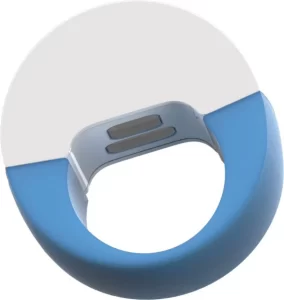Wellness at Every Age: The Ultimate Guide to Fitness Trackers for Seniors
Fitness Trackers for Seniors
Imagine a world where age is just a number and wellness knows no bounds. In this world, fitness and health are not limited to the young and sprightly but are embraced by individuals of all ages. Welcome to the ultimate guide to fitness trackers for seniors!
We believe that staying active and taking care of your well-being should never be restricted by age. That’s why we’re here to introduce you to the wonderful world of wearable technology for seniors . Whether you’re a tech-savvy senior or new to the realm of smart devices, we’ve got you covered.
In this comprehensive guide, we’ll explore what fitness trackers are, how they work their magic, and most importantly, which ones are best suited for our beloved elders. It’s time for seniors everywhere to embrace the power of wearable technology as an essential tool in maintaining their physical and mental well-being.
So fasten your seatbelts (or rather wristbands), because we’re about to take you on an exciting journey into the realm of wearable wonders that will revolutionize how you approach health and wellness at every stage of life. Let’s get started!
The Importance of Fitness at Any Age
Maintaining fitness and prioritizing our well-being is crucial at any age. While the demands of life may change as we grow older, the importance of staying active remains constant. Regular physical activity not only helps to improve strength, flexibility, and balance but also plays a vital role in preventing chronic diseases such as heart disease, diabetes, and even certain types of cancer.
Engaging in fitness activities can also have a positive impact on mental health. Exercise releases endorphins that boost mood and reduce feelings of stress and anxiety. It can enhance cognitive function, improve memory retention, and foster a sense of overall well-being.
Additionally, staying active promotes independence by helping seniors maintain their mobility for everyday tasks like shopping or gardening without relying heavily on assistance from others. It allows them to enjoy an active lifestyle filled with activities they love while reducing the risk of falls or injuries.
Fitness isn’t just about intense workouts either; it’s about finding enjoyable ways to move your body regularly. Whether it’s taking leisurely walks in nature or participating in low-impact exercises like swimming or yoga classes specifically designed for seniors – every little bit counts!
Remember that age should never be a barrier when it comes to embracing wellness. By incorporating fitness into our daily lives no matter what stage we’re at, we open ourselves up to endless possibilities for improved physical health and emotional well-being. So lace up those walking shoes or strap on that fitness tracker – let’s embark on this incredible journey towards wellness together!
What Are Fitness Trackers and How Do They Work?
Fitness trackers have become increasingly popular in recent years, and for good reason. These wearable devices are designed to help individuals track their physical activity levels throughout the day. But what exactly are fitness trackers and how do they work?
At their core, fitness trackers are electronic devices that monitor various aspects of your daily movements and provide you with valuable insights into your overall health and wellness. They typically come in the form of a wristband or a clip-on device that can be easily worn throughout the day.
One of the main features of fitness trackers is their ability to measure steps taken, distance traveled, and calories burned. This information is then displayed on a screen or accessed through a corresponding mobile app. Fitness trackers also often include additional features such as heart rate monitoring, sleep tracking, and even GPS capabilities.
The technology behind these devices relies on sensors that detect motion and other physiological changes within your body. For example, an accelerometer measures movement patterns while an optical heart rate sensor detects changes in blood flow under the skin.
By collecting data about your daily activities, fitness trackers allow you to set goals, track progress over time, and make informed decisions about your lifestyle choices. They serve as constant reminders to stay active throughout the day by providing real-time feedback on your movement levels.
Fitness trackers offer users an easy way to keep tabs on their physical activity levels and motivate them towards leading a healthier lifestyle. Whether you’re taking small steps towards better health or striving for more intense workouts, these gadgets can play a significant role in helping seniors stay fit at any age
Top Features to Look for in a Fitness Tracker for Seniors
When it comes to choosing a fitness tracker for seniors, there are some key features that can make all the difference in ensuring its effectiveness and suitability. Here are the top features to look for:
1. Easy-to-Read Display: A fitness tracker with a clear and large display is essential for seniors, as it allows them to easily view their stats without straining their eyes.
2. Simple Operation: Look for a tracker with intuitive controls and user-friendly interface. Seniors may prefer buttons over touch screens, as they can be easier to navigate.
3. Heart Rate Monitoring: This feature is important for seniors who want to keep track of their cardiovascular health. It helps monitor heart rate during exercise and rest, providing valuable insights.
4. Step Counting: Tracking daily steps is a fundamental feature in any fitness tracker. It encourages seniors to stay active by setting goals and monitoring progress throughout the day.
5. Sleep Tracking: Adequate sleep plays an important role in overall wellness at any age. A fitness tracker that includes sleep tracking functionality can help seniors understand their sleep patterns and make adjustments if needed.
6. Calorie Burn Tracking : Being able to accurately estimate calorie burn can assist in maintaining a healthy weight or reaching specific weight loss goals.
7. GPS Functionality : For seniors who enjoy outdoor activities such as walking or jogging, GPS functionality can provide accurate distance measurements and route tracking capabilities.
By considering these top features when choosing a fitness tracker, you’ll be well-equipped to find one that suits the specific needs of senior individuals seeking improved health and wellness through wearable technology.
Best Fitness Trackers for Seniors – Reviews and Recommendations
When it comes to choosing the best fitness tracker for seniors, there are a few key features to consider. One important factor is ease of use. Look for a tracker that has a simple interface with large, easy-to-read numbers and buttons.
Another feature to look out for is heart rate monitoring. This can be especially useful for seniors as it allows them to track their cardiovascular health during exercise or daily activities.
One highly recommended fitness tracker for seniors is the Fitbit Charge 4. It offers all-day activity tracking, including steps taken, distance covered, calories burned, and active minutes. The Charge 4 also includes built-in GPS so you can accurately track outdoor workouts without needing your phone nearby.
For those who prefer a more budget-friendly option, the Letscom Fitness Tracker is worth considering. It offers similar features to more expensive trackers at a fraction of the price. With its long battery life and waterproof design, it’s suitable for everyday wear.
If you’re looking for something beyond just tracking physical activity, consider the Apple Watch Series 6. In addition to fitness tracking capabilities like step counting and heart rate monitoring, it also offers advanced health features such as blood oxygen level measurement and fall detection.
The best fitness tracker will depend on individual preferences and needs. Whether you prioritize simplicity or advanced health monitoring, there are options available that cater specifically to seniors’ requirements.
Tips for Using a Fitness Tracker as a Senior
- Start Slow: If you’re new to fitness trackers, it’s important to start slow and gradually increase your activity levels. Set realistic goals that are achievable for your age and fitness level.
2. Wear It Consistently: To get the most out of your fitness tracker, make sure to wear it consistently throughout the day. This will help you accurately track your steps, heart rate, and other metrics.
3. Use the App: Most fitness trackers come with a companion app that allows you to sync and analyze your data. Take advantage of this feature by regularly checking in on your progress and adjusting your goals accordingly.
4. Listen to Your Body: While fitness trackers can provide valuable insights into your health and activity levels, it’s important to listen to your body above all else. If you’re feeling fatigued or experiencing pain, take a break and rest.
5. Stay Motivated: One of the greatest benefits of using a fitness tracker is the motivation it provides. Set challenges for yourself, participate in virtual competitions with friends or family members, and celebrate small milestones along the way.
6. Stay Hydrated & Nourished : Remember to stay hydrated during exercise and maintain proper nutrition for overall wellbeing.
Remember, using a fitness tracker as a senior is about taking control of your health journey at any age!
Other Ways to Stay Active and Healthy as You Age
As we age, staying active and maintaining good health becomes even more important. While fitness trackers can be a great tool to help monitor our physical activity, there are also other ways to stay active and healthy as we age. Here are some suggestions:
1. Engage in regular exercise: Participating in activities such as walking, swimming, or yoga can help improve flexibility, strength, and cardiovascular health.
2. Stay socially connected: Maintaining social connections is crucial for mental well-being. Joining clubs or organizations that align with your interests can provide opportunities for companionship and intellectual stimulation.
3. Prioritize nutrition: A balanced diet rich in fruits, vegetables, lean proteins, and whole grains is essential for overall health. It’s important to pay attention to portion sizes and avoid processed foods high in salt and sugar.
4. Get enough sleep: Quality sleep plays a vital role in maintaining physical and mental well-being. Establishing a consistent bedtime routine and creating a calm sleeping environment can promote better sleep habits.
5. Practice stress management techniques: Chronic stress can have negative effects on our health. Engaging in activities like meditation, deep breathing exercises, or practicing mindfulness can help reduce stress levels.
Remember that wellness encompasses more than just physical fitness – it includes emotional well-being too! By adopting these lifestyle habits along with using fitness trackers to monitor your progress – you’ll be on the right track towards achieving optimal wellness at any age!
Conclusion: Embracing Wellness at Every Stage of Life
Throughout our lives, it is essential to prioritize our health and well-being. And as we age, maintaining an active lifestyle becomes even more important. Fitness trackers have emerged as valuable tools for seniors looking to stay fit and monitor their progress.
With the advancements in wearable technology for seniors, there are now a variety of fitness trackers specifically designed with older adults in mind. These devices not only track your physical activity but also provide insights into other aspects of your health, such as heart rate monitoring and sleep tracking.
When choosing a fitness tracker for seniors, it’s crucial to consider certain features that cater to their unique needs. Look for models with larger screens and easy-to-read displays, simple navigation menus, long battery life, and comfortable wristbands.
Some top recommendations include the dhyana Smart Ring, Fitbit Charge 4, Garmin Vivosmart 4, and Apple Watch Series 6 – all offering excellent functionality while being user-friendly for seniors.
Using a fitness tracker as a senior can be empowering. It allows you to set goals and track your progress over time. However, it’s important to approach this technology with some tips in mind:
– Start slow: Ease into using your fitness tracker by gradually increasing your activity levels.
– Set achievable goals: Focus on small milestones rather than overwhelming yourself with unrealistic objectives.
– Listen to your body: Remember that exercise should always be enjoyable and suit your individual abilities.
– Stay motivated: Use the data provided by your fitness tracker as motivation to keep moving forward on your wellness journey.
While fitness trackers are fantastic tools for promoting physical activity among seniors, they are just one piece of the puzzle when it comes to overall wellness. There are plenty of other ways you can actively maintain good health:
1. Engage in social activities: Staying socially connected has been linked to better mental health outcomes.
2. Practice mindfulness techniques: Consider incorporating meditation or relaxation exercises into your routine.
3. Prioritize nutrition: A well-balanced diet is essential for staying healthy and maintaining energy levels.
4. Get enough rest: Quality sleep is crucial for overall health and can help prevent a variety of health issues.
5. Stay mentally engaged: Keep your mind sharp by challenging yourself with puzzles, games, or learning new skills.
In conclusion, embracing wellness at every stage of life means finding ways to take care of yourself physically, mentally, and socially. Fitness trackers are excellent tools for seniors looking to stay active but should be used in conjunction with other healthy habits. Remember to listen to your body, set achievable goals, and enjoy the journey towards better health and well-being.






